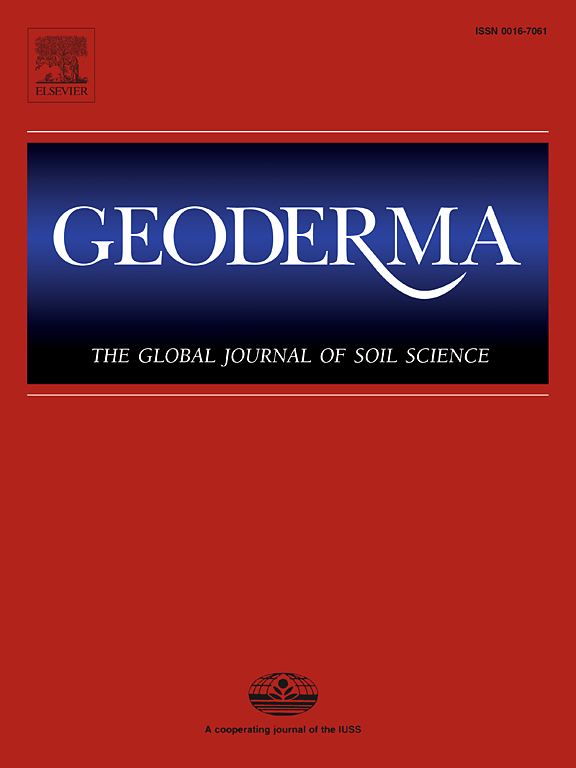潮汐驱动的生物地球化学梯度塑造了潮间带湿地暗碳固定的垂直轮廓
IF 5.6
1区 农林科学
Q1 SOIL SCIENCE
引用次数: 0
摘要
暗固碳(DCF)是滨海湿地生物地球化学循环中一个重要的碳汇过程。潮间带湿地的潮汐水动力对湿地的理化条件有显著影响,但对DCF活动及相关的化养生物的影响尚不清楚。利用14C同位素示踪和宏基因组技术研究了潮间带沉积物中DCF率的垂直分布规律和趋化自养生物的动态。结果表明,DCF率在近表层(10 ~ 35 cm, 110.13±28.71 mmol C m−3·d−1)最高,而在表层(0 ~ 10 cm, 20.19±5.93 mmol C m−3·d−1)和深层(80 ~ 100 cm, 13.79±1.28 mmol C m−3·d−1)相对较低。亚表层中较高的DCF活性可能归因于更多的还原底物,如硫化物和亚铁(Fe2+),以及潮汐波动形成的氧化还原梯度。宏基因组分析表明,Wood-Ljungdahl (WL)循环是潮间带沉积物中趋化自养生物的主要固碳途径。本研究估计的DCF通量(50.96 mmol C m - 2 d - 1)明显高于以前报道的仅从地表沉积物中获得的速率。综上所述,本研究增强了我们对复杂DCF过程的认识,为更准确地评价潮间带湿地碳汇潜力提供了科学依据。本文章由计算机程序翻译,如有差异,请以英文原文为准。
Tide-driven biogeochemical gradient shapes the vertical profile of dark carbon fixation in intertidal wetlands
Dark carbon fixation (DCF) is recognized as a vital carbon sink process in the biogeochemical cycle of coastal wetlands. Tidal hydrodynamic dynamics in intertidal wetlands significantly affect the physicochemical conditions, yet their impacts on DCF activities and the associated chemoautotrophs remain unclear. Here, we investigated the vertical distribution patterns of DCF rates and the dynamics of chemoautotrophs in intertidal sediments using 14C isotope tracing and metagenomic techniques. Results showed that DCF rates peaked in the subsurface layer (10–35 cm depth, 110.13 ± 28.71 mmol C m−3·d−1), but were relatively lower in the surface layer (0–10 cm, 20.19 ± 5.93 mmol C m−3·d−1) and the deep layer (80–100 cm, 13.79 ± 1.28 mmol C m−3·d−1). Higher DCF activities in the subsurface layer might be attributed to more sufficient reducing substrates such as sulfide and ferrous iron (Fe2+), as well as the redox gradient shaped by tidal fluctuations. Metagenomic analysis highlighted that the Wood-Ljungdahl (WL) cycle was the predominant carbon fixation pathway for chemoautotrophs in intertidal sediments. The estimated DCF flux measured in the present study (50.96 mmol C m−2 d−1) was significantly higher than previous reported rates obtained exclusively from the surface sediments. In conclusion, this study enhances our understanding of the complex DCF process and provides scientific support for a more accurate evaluation of the carbon sink potential in intertidal wetlands.
求助全文
通过发布文献求助,成功后即可免费获取论文全文。
去求助
来源期刊

Geoderma
农林科学-土壤科学
CiteScore
11.80
自引率
6.60%
发文量
597
审稿时长
58 days
期刊介绍:
Geoderma - the global journal of soil science - welcomes authors, readers and soil research from all parts of the world, encourages worldwide soil studies, and embraces all aspects of soil science and its associated pedagogy. The journal particularly welcomes interdisciplinary work focusing on dynamic soil processes and functions across space and time.
 求助内容:
求助内容: 应助结果提醒方式:
应助结果提醒方式:


